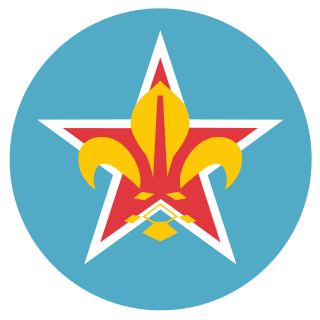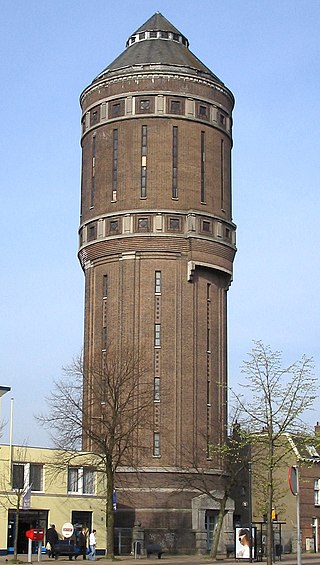
Schagen is a city and municipality in the northwestern Netherlands. It is located between Alkmaar and Den Helder, in the region of West Friesland and the province of North Holland. It received city rights in 1415. In 2013, Schagen merged with Zijpe and Harenkarspel. Together they have formed a new municipality, which is also called Schagen. The townhall is located in the main town of Schagen.
Thierry Veltman was a Dutch painter, sculptor, ceramist, graphic artist and art educator. He focused in particular on figures and still life.

Scouting in Aruba shared a common history with the other Netherlands Antilles until the political separation of the island from the Netherlands. Scouting Aruba is a Full Member of the Interamerican Region of the World Organization of the Scout Movement.

ASWH, short for Altijd Sterker Worden Hendrik-Ido-Ambacht, is an association football club from Hendrik-Ido-Ambacht, Netherlands. The club was founded in 1929. It won section championships in 1949, 1959, 1961, 1970, 1883, 1999, 2001, 2002, 2005, and 2024. In 2005 ASWH also won the Dutch Championship of Amateur Soccer and the Dutch Championship of Saturday Soccer. Ascending gradually through the ranks, ASWH played 2019–2022 in the semi-professional Tweede Divisie. In 2023, it joined the Vierde Divisie, after relegating twice for the first time in the club's history. In 2023–2024, ASWH operates 70 teams in competitions.
Joey Godee is a Dutch footballer who plays for Dutch Vierde Klasse club HVC Amersfoort.
Robine Tanya van der Meer is a Dutch actress and model. She is best known as Meike Griffioen in Goede tijden, slechte tijden and for hosting the TV-show Model in 1 dag.

Simon Berman was the mayor of Kwadijk, Middelie, Warder, Schagen, Bedum, and Alblasserdam in the Netherlands. He was the first mayor of Kwadijk, Middelie, and Warder to actually live in one of those villages. As a popular mayor of Schagen, he handled a double murder case that drew national media attention and advanced a professional school and regional light rail and canals. In Alblasserdam, he addressed the local impacts of World War I. Berman is also known for his association with Christian anarchism.
Luis Pedro da Silva Ferreira is an Angolan-Dutch formerly professional footballer. He plays as a centre back. Pedro is a resident of Rotterdam.

RKSV Nuenen is a football club from Nuenen, Netherlands. The first squad of Nuenen is playing in the Sunday Hoofdklasse since 2016. The first women squad plays in the Hoofdklasse for women since 2014 or 2015.
Joost Berman was a Dutch lawyer, judge, politician, poet, nonfiction writer, and editor.

Omroep Zeeland is a public broadcaster located in Zeeland, Netherlands. Founded in 1988, the media organization is active in television, radio, and internet. The audience is on average slightly older than that of the other Dutch regional broadcasters.
Cesco Agterberg is a Dutch football manager and the head coach of Hoofdklasse club SDC Putten.
2018–19 Eerste Klasse was a Dutch Eerste Klasse association football season of the Eerste Klasse.
Jan van Raalte is a Dutch football manager of amateur squads and formerly a professional footballer, mostly in the Eerste Divisie and one season with Cambuur Leeuwarden in the Eredivisie. Van Raalte won the Rinus Michels Award for coaching amateur teams. He lives in Harkema where he finished his midfield player career.
Ecotribe Teuge is a collective of people living on a squatted terrain in the Dutch countryside. It is located on the edge of the village of Teuge, in the province of Gelderland. The buildings were constructed by the Nazis and formerly used to house Moluccan soldiers. The site was occupied in 2001, when people began to live there in an off-the-grid and self-sufficient manner. Since 2018, there are plans by the province to develop the terrain.

The Tabakspanden are a group of buildings standing on the Spuistraat in central Amsterdam, adjacent to the Keizerrijk and Wijdesteeg alleyways. Named after a former owner, the speculator Hendrik Tabak, they were mostly squatted from 1983 onwards, although the artist Peter Klashorst also rented an apartment and gallery space. The best known building was Spuistraat 199, known as the Slangenpand (Snakehouse) because of the large mural which covered the front exterior. In 2015, the squatters were evicted and the buildings were mostly demolished prior to redevelopment. The new project is known as De Keizer and has 69 apartments, a restaurant and a gallery. Two of the buildings are registered as rijksmonumenten.
Arie van der Zouwen is a Dutch football coach and former player. He was the manager of the Hong Kong national team and both assistant manager and manager of Al Wahda FC. He resides in Kortgene.

The Ubica buildings are two adjacent buildings standing at 24 and 26 Ganzenmarkt, in central Utrecht, the Netherlands. Number 24 is a rijksmonument. The first recorded mention of the buildings is from 1319. After centuries of residential use, the buildings were bought by the Ubica mattress company in 1913 and used until a devastating fire in 1989. The buildings were then squatted for 21 years, before being redeveloped into a hotel and café-restaurant in 2014.

The Amsterdamsestraatweg Water Tower is located in Utrecht, the Netherlands. The water tower was built at Amsterdamsestraatweg 380 in 1916, in the style of the Amsterdam School. It became derelict in 1986 and was repeatedly squatted before its redevelopment into apartments began in 2020.

Takdier Boys–Amardeep Combinatie 1990 is an association football club from The Hague, Netherlands. In 2020–21, its Sunday first squad plays for the first time in the Hoofdklasse and Saturday first squad plays in the Vierde Klasse.










